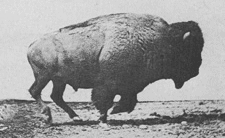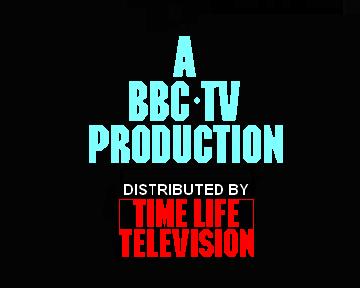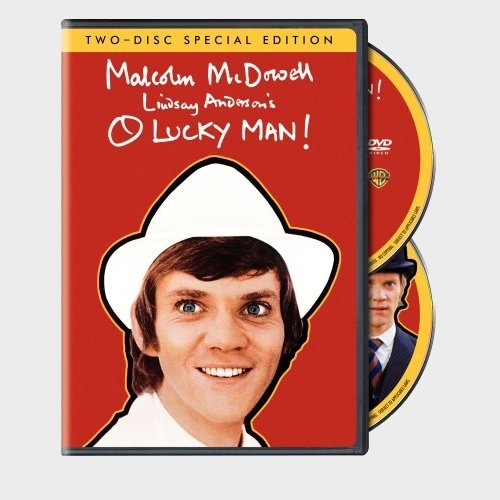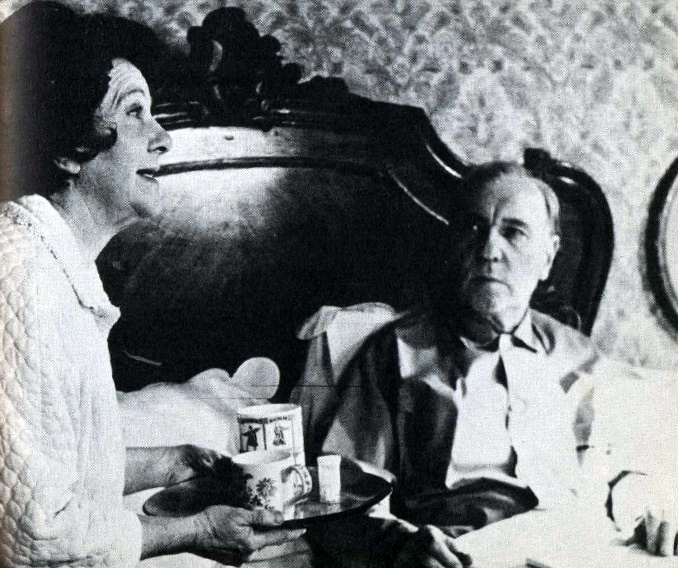

 |
 |
O LUCKY MAN!
Release date: Tuesday, 23 October 2007. Warner Home Video. 2 discs. Includes commentary track by Malcolm McDowell, David Sherwin, and Alan Price. Includes original preview, promo featurette, and a new documentary, O Lucky Malcolm! Optional English and French captions. Suggested retail price $19.98. Region 1. NTSC. Product number 120031.
For those of us who have been victimized by
In the course of what seems to be a mere few days,
Mick unexpectedly rises from neophyte trainee to chief traveling coffee salesman,
in which rôle he encounters deadly police, tabloid editors and bacchanalian politicians,
inadvertently cuckolds his new landlord, is arrested as a Soviet spy, barely survives a nuclear meltdown,
escapes a fate as a human guinea pig, is given sanctuary by a roving rock band, and is seduced by the delightful Patricia,
daughter of the world’s most evil industrialist, Sir James Burgess.
Wishing to make his way up in the world, Mick determines to ingratiate himself to Sir James, who hires him on the spot.
After having witnessed a suicide and accidental death caused by Sir James’s double-dealings,
and after having been invited to a secret meeting at which various other industrialists and politicians collude
to stabilize an African economy by means of unleashing chemical weapons upon the populace,
Mick feels cautiously secure in his new rôle as lackey.
It is subtle body language alone that conveys his doubts, which will soon be laid to rest.

The chauffeur-driven Rolls-Royce deposits Sir James at his house and Mick makes ready to depart.
Sir James acts surprised: “Where are you going?”
“Home, sir,” replies Mick.
“No, no, no — that won’t work at all.”
The butler Jenkins leads Mick through the palatial residence, offers pyjamas, and makes a simple announcement:
“Dinner is prawn cocktail and leg of mutton. What would you care to drink?”
Mick decides to test the hospitality, and asks, “Champagne?”
Alone in the living room, Mick notices a cassette tape and a stereo system.
He plays the tape, which thunders out Alan Price’s song “Sell, Sell, Sell.”
Mick continues his explorations in the bedroom.
In the otherwise-empty closet are a pair of hunting boots and a white polo hat.
He puts them on and calls Sir James’s daughter Patricia on one of the two telephones.
She is not home, but one of the band members answers.
“Well, listen, I’m the bloke you picked up last night, the one in the gold suit.
Yes. Actually, I’m personal assistant to her father now.
Well, why should I be joking?...
Can you tell her, just tell her I’ve tamed the Tiger....”
He dashes back out to the living room to answer a buzzer.
He tries all three phones, to no avail, and Jenkins directs him to the intercom.
“Michael Travis speaking.” It is Sir James asking for him.
Mick begins to dash down the hall but Jenkins diplomatically points out that he is still wearing the polo hat.
Mick removes it and makes his way with all speed.
Sir James is in his pyjamas, sitting up in bed counting a wad of ten-pound notes into an envelope.
Mick is to deliver this envelope, hidden in a magazine, to the Right Honourable Basil Keyes at the National Political Club.
Sir James casually mentions the map coördinates, 973 670, amongst the full directions.
He tests Mick and is pleased to see that, in his eagerness, he has effortlessly memorized those coördinates.
Sir James’s wife, Lady Burgess, enters in her dressing gown, carrying a tray of cocoa.
Sir James introduces them: “Meet my wife. Mummy, this is Michael.”
Sir James inquires after the accommodations, hoping that the mattress is not too hard for Mick’s liking.
But everything is perfect.
As Lady Burgess climbs into bed with her husband, Sir James calls out sharply,
“And hold that damn magazine folded — in two — so that the envelope doesn’t fall out!”
Mick has heard.
Lady gives Sir his pills and his cocoa, and those of us in the know understand that Mick has sealed his own doom.

This little scene is precious, telling, subtle, funny, frightening, and utterly memorable.
But chances are that you don’t remember it,
because it was cut shortly after the film’s première in the UK and has never been reinstated.
Why is this, you ask?
Warner Bros., which sponsored, funded, and distributed
Roll 16 had been another little gem,
consisting of Mick’s torturous encounter with the Salvation Army,
his failed attempt to save a woman from suicide, and a silent-movie sequence in which he is maltreated by a policeman.
Without Roll 16, there is a bit of further imbalance.
The movie starts with a title telling us that we are in the “WEST.”
Shortly thereafter the movie shifts locale and we journey to the “NORTH.”
After Mick is given refuge by the band, we go “SOUTH.”
But what happened to EAST? It was gone.
It had opened Roll 16, leading into the Salvation Army.
It was sometime around 1978,
after
As for the five-minute scene of Mick’s night at Sir James’s house,
well, no one remembered it.
To this day no one remembers it.
But it was there in the original 183-minute version.
The published script (London: Plexus, 1973),
which was actually not the script at all but a transcript of the final cut of the movie, includes the scene.
The restored version available now to cinemas and to home video runs only 178 minutes.
So, where can we see the five extra minutes?
If that lone print of the original release still exists somewhere in the Warner vaults,
perhaps someone can coerce the studio heads to allow it to be examined and copied.
Failing that, we’ll never see it.
And that would be a terrible loss.
NEWS FLASH! As recently as 1982 the uncut, complete O Lucky Man!, including the above five-minute scene,
was shown on the BBC.
See J. R. Kerr’s capsule review at Amazon.co.uk
for the story.
Did anyone happen to record this?
If so, PLEASE WRITE TO ME IMMEDIATELY!!!!!
We need to locate and rescue the copy that the BBC broadcasted that night.
And we need to demonstrate that the scene actually existed and was included in the original “director’s cut.”
THIS IS OF CRITICAL IMPORTANCE, AS THAT FIVE-MINUTE SCENE IS EFFECTIVELY LOST,
AND AS OLD COPIES OF MOVIES ARE ROUTINELY DISCARDED ONCE THEY WEAR OUT.
IF WE DO NOT TAKE ACTION RIGHT AWAY, THERE IS A GOOD CHANCE THAT THE ONLY COPY OF THE FILM WITH THIS MATERIAL WILL BE DESTROYED.
So much for the back story.
What about the movie itself?
It’s marvelous!
To get perhaps unduly personal,
I remember that at age 15 I was intrigued by the indescribably jolly poster
of a smiling Malcolm McDowell surrounded by a fat cartoon outline.
I decided to watch this movie which was being advertised as having a PG rating.
After having been deposited by my father at the cinema I was mortified to discover an R rating on the poster.
What was I to do?
The management of that particular repertory cinema had no respect for ratings at all and were happy to sell me a ticket.
But that wasn’t the issue; there was something called morality involved:
How could I dare to watch such corrupting filth?
When the cinema’s staff finally recovered from their gales of laughter,
they managed to talk me into seeing it anyway.
The poster that had so caught my fancy had by now created a temptation too great for me to resist.
Besides, I had already been dropped off at the cinema and there was no place else to go!
So I gave in and purchased a ticket,
but on condition that I watch the movie in relative anonymity from the projection booth.
It was a done deal.
What I saw on that screen that night had a life-long impact.
It was transformative.
Everything about the story, the acting, the look of the film, the sound of the film,
was so rich that it was difficult to take it all in at a single viewing.
I was entranced.
I had never seen anything remotely like it.
As my life had, until that time, consisted of nought but circumstance brought about by accident, entirely out of my control,
I could relate to the general thrust of the narrative, which explored the picaresque adventures of the overly ambitious Mick
who had no control over his own destiny.
(My life since that time has spun even more wildly out of my control, and, largely because of
On that night in 1975 something else also surprised me.
Back in 1973 or thereabouts I had seen a sticker that someone had stuck to a lamp post
at the northwest corner of Menaul and Louisiana in Albuquerque.
I didn’t understand it but got a chuckle out of it.
I pointed it out to my sister who had an identical reaction.
The sticker had written on it, in a staccato script mimicking handwriting,
a mysterious little verse.
It looked something like this:

In Reel 2 of
Wanting to know more about the movie’s makers,
I dug through the local libraries to research David Sherwin,
Malcolm McDowell, and Lindsay Anderson, and what I learned impressed me deeply.
One thing I discovered was that they had all collaborated on a previous movie called if....,
which I would not be able to see for years.
But the published script was still in print and I read it several times over.
When I finally did see the movie, on cable TV in the mid-1980’s, I fell in love with it.
Eventually I was thrilled to discover that I would project a 35mm print for the Buffalo Film Seminars.
Handling those six reels of celluloid was like handling the holy of holies.
Both if.... and
We owe it to Malcolm McDowell that this movie is finally available on DVD.
Warner Bros. never seemed too interested in it.
They had released it twice on VHS in this country, in 1981 or thereabouts and then again in 1989,
and in 1998 they briefly released it on laserdisc, but a DVD seemed out of the question.
Then when Warner offered McDowell the job of doing a commentary track for A Clockwork Orange,
he agreed but only on condition that they release
Now for the technical end.
While the laserdisc was matted correctly at 1:1.85,
the DVD is matted at the slightly more generous — and slightly more British — 1:1.78.
Further, the DVD is anamorphic to fill the width of a high-def television set.
Now, I hear you all ask, since when was a British film composed for projection at 1:1.85?
British films of the time were generally framed for 1:1.66 or 1:1.75.
Well, when the US money guys tell the British techies to frame a movie the American way,
their word is law, and so
Watch the DVD.
After you watch it, watch it again.
Let it sink into the deepest levels of your subconscious.
Learn the songs and sing along.
And remember, above all, the movie’s greatest lesson:
“Try... not to die... like a dog!”
Any readers who have more information on the technical details —
or who know where I can get that sticker! —
or who know where that missing scene is hiding! — are welcome to contact me at
former.rjbuffalo@gmail.com.
Original research and commentary copyright © 2008 by Ranjit Sandhu. All rights reserved.
|